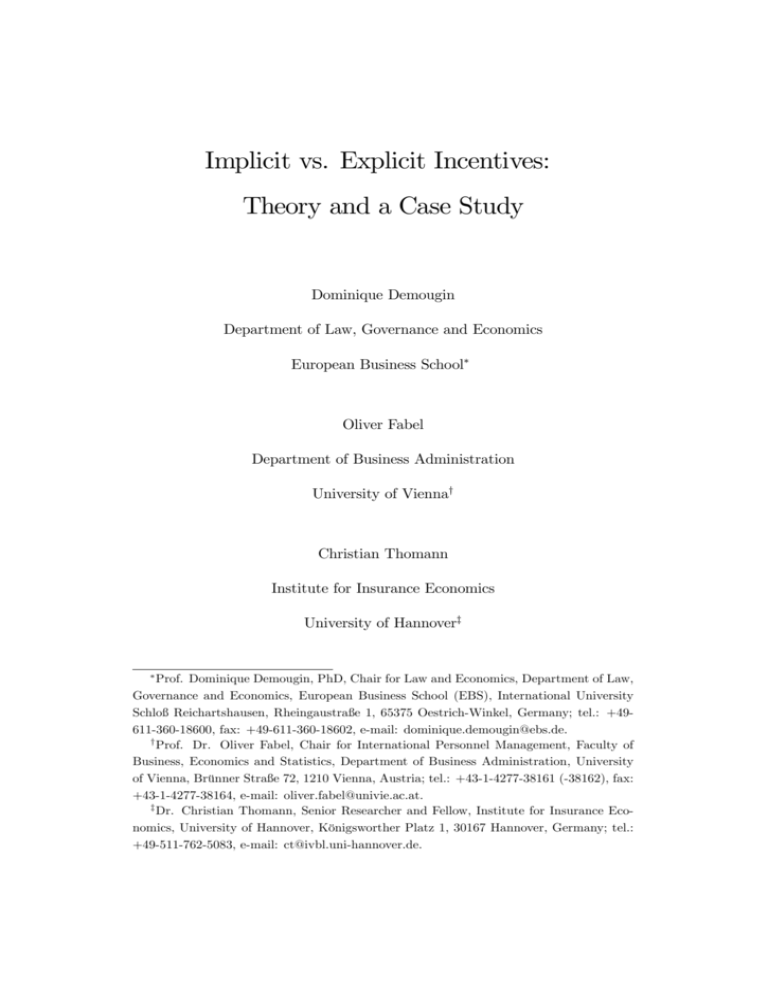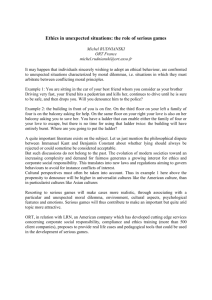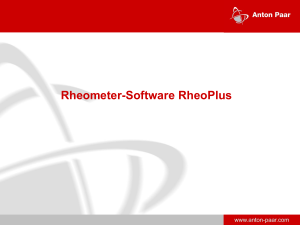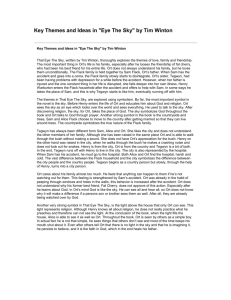Implicit vs. Explicit Incentives: Theory and a Case Study
advertisement

Implicit vs. Explicit Incentives: Theory and a Case Study Dominique Demougin Department of Law, Governance and Economics European Business School Oliver Fabel Department of Business Administration University of Viennay Christian Thomann Institute for Insurance Economics University of Hannoverz Prof. Dominique Demougin, PhD, Chair for Law and Economics, Department of Law, Governance and Economics, European Business School (EBS), International University SchloßReichartshausen, Rheingaustraß e 1, 65375 Oestrich-Winkel, Germany; tel.: +49611-360-18600, fax: +49-611-360-18602, e-mail: dominique.demougin@ebs.de. y Prof. Dr. Oliver Fabel, Chair for International Personnel Management, Faculty of Business, Economics and Statistics, Department of Business Administration, University of Vienna, Brünner Straß e 72, 1210 Vienna, Austria; tel.: +43-1-4277-38161 (-38162), fax: +43-1-4277-38164, e-mail: oliver.fabel@univie.ac.at. z Dr. Christian Thomann, Senior Researcher and Fellow, Institute for Insurance Economics, University of Hannover, Königsworther Platz 1, 30167 Hannover, Germany; tel.: +49-511-762-5083, e-mail: ct@ivbl.uni-hannover.de. Implicit vs. Explicit Incentives: Theory and a Case Study Abstract: THIS VERSION IS INCOMPLETE AND VERY PRELIMINARY. PLEASE, DO NOT CITE YET. 1 Introduction We examine a contracting problem between a risk-neutral principal and an agent that is risk-neutral but liquidity constrained in a stochastically repeated environment. The incentive scheme comprises two parts: contingent on the realization of a veri…able - i. e. court-enforceable - monitoring signal, the principal can o¤er an explicit bonus. In addition, he can condition a salary promise on the observation that the agent’s e¤ort supply satis…es an implicitly agreed threshold level. Since the agent’s e¤ort supply cannot be veri…ed by third parties, this promise must be self-enforceable. The agent’s rent increases with the explicit bonus. Thus, the principal can extract more of this rent by substituting explicit by implicit incentives. However, the self-enforcement requirement may impose an upper limit on the credible salary promise. In this case, the exogenous probability that the agent terminates the contract prematurely determines the trade-o¤ between implicit and explicit incentives. Speci…cally, the bonus increases and the salary promise decreases with a higher probability of premature contract termination.. At the same time, the agent’s e¤ort supply and, hence, productivity then decrease. We test our model using personnel data released by a large insurance company. The dataset contains detailed information on individual revenues, compensation, and other characteristics of more than 300 employees over the course of …ve years. On …rst sight, the data impart some puzzling evidence: contrasting with standard, static principal-agent theory more payfor-performance appears to reduce productivity. However, these observations are well compatible with our approach emphasizing the repeated nature of contracting. Thus, we proceed to investigate the trade-o¤s in the incentive structure that are induced by di¤erences in individual expected contract duration. We estimate the latter using mean survival time models. Expected contract duration can then be shown to increase …xed salary while decreasing 1 variable pay. Subsequently, we investigate the e¤ects on individual productivity. In particular, we use the individual’s predicted survival time both as a control variable and, as indicated by our theory, as an instrument for the two components of the compensation scheme. We show that the productivity e¤ect of expected contract duration is primarily con…ned to the trade-o¤ between …xed and variable pay. Generally, the econometrics very strongly support our theoretic approach. The standard, one-period principal-agent model is often considered the building block of incentive theory.1 Also, Lazear’s (2000) successfully tests its implications within a work environment, the Safelite case, that rather perfectly …ts the model assumptions.2 In general, however, empirical evidence on the e¤ects of incentive pay may still be termed “tenuous”.3 According to Jensen and Murphy (1990) already, executive contracts lack strong performance-pay incentives. More recently, Freeman and Kleiner (2005) show that, due to monitoring and transaction costs, a piece rate system may increase labor productivity but not pro…ts. Moreover, the announcement of future time rates increases productivity by twice the percentage realized when introducing piece-rates. Further, a series of very well-crafted studies by Prendergast (1999, 2000, 2002a, 2002b) demonstrates that incentive intensities do not necessarily decrease with more uncertainty as predicted by the standard model. Explanations typically rely on additional assumptions regarding the contracting environment.4 Hence, Jensen and Murphy (1990) suggest that political forces both in the public sector and inside the organizations place limits on incentives for CEOs. According to Prendergast (2002a), private information becomes more valuable - and, thus, the moral hazard problem more acute - if the environment becomes more risky. Prendergast (2002b) 1 See Lazear and Oyer (2007), for instance. Prendergast (1999). 3 Prendergast (2002a). 4 More radical, experimental economics suggests that an employee’s e¤ort supply is actually governed by a gift exchange motive derived from reciprocal preferences rather than monetary incentives. See Gächter et al. (1997) and, more recently, Hannan (2005), for instance. 2 2 adds that favoritism of supervisors can lead to lower incentive-intensities in less risky environments. More radical, experimental economics suggests that, rather than induced by monetary incentives, an agent’s e¤ort supply is governed by a gift exchange motive that re‡ects reciprocal preferences.5 Clearly, our approach is more traditional: Baker et al. (1994) and Pearce and Stacchetti (1998) already analyze the interplay between implicit and explicit incentives that arises with the availability of both objective and subjective performance signals. However, they primarily focus on the distributional e¤ects of distorted or biased signals on the agent’s risk-premium. Drawing on MacLeod and Malcomson (1989), Levin’s (2003) repeated agency model then distinguishes common and private performance monitoring. With risk-neutral principal and agent, court-enforceable performance pay and selfenforcing income promises constitute perfect substitutes. In contrast, we show that implicit salary promises always dominate if the agent is liquidity-constrained. However, such promises may not be credible. In this case, the contract comprises additional explicit performance pay. Since the agent then captures a rent, her e¤ort supply is only secondbest. Moreover, our model is very tractable and yields testable implications concerning the trade-o¤s between the two incentive devices and the determinants of e¤ort supply. To our knowledge, only Hayes and Schaefer (2000) investigate implicit contracts empirically. They show that the unexplained variation in current CEO-compensation is positively correlated with the future …rm performance.6 The employees contained in our dataset coordinate the sales force of a large and long-established German insurance company. Using actual personnel data, we can observe individual productivities., salaries, commissions and bonuses, and many other characteristics of the employees’tasks, career status, and job environment. We can track these employees from January 2003 5 See Gächter et al. (1997) and, more recently, Hannan (2005), for instance. Else, the existing evidence is rather circumstantial: for instance, Rayton (2003) reports that, although contracts lack explicit incentives based on …rm performance, rank-and-…le employees’incomes exhibit considerable performance sensitivities. 6 3 until December 2007. Thus, the dataset comprises 1123 employee-year observations for 317 individuals. Since average employee tenure is longer than 10 years, this data appears particularly well-suited to study reputational contracting. Eisner and Stotz (1961) already claim that insurance contracts are “sold rather than bought.” Insurance companies should therefore be very experienced in designing incentive contracts. Also, performance pay induces signi…cant costs: in 2004, for instance, German life insurers paid out 16:3% of their gross premium revenue as commissions to their sales organizations.7 However, empirical research has so far been mostly con…ned to analyses of distribution channels.8 With the exception of Cummins and Doherty (2006) who discuss the New York Attorney General’s 2005 investigation into the possible adverse incentive e¤ects of contingent commissions, the design of incentive contracts in the insurance industry has not been studied yet. Our contribution is therefore threefold: …rst, we provide a novel theoretic approach to analyze the interplay of explicit and implicit incentives. Second, we can rather directly test this particular mechanism using personnel data. Third, focussing on rank-and-…le employees of an insurance company, we also provide new insights into the “real-world”design of incentive contracts. The study proceeds as follows. Section 2 develops the theoretic model. Section 3 introduces the dataset and contains the econometric investigation. Section 4 concludes. 7 For the American property and casualty market Cummins and Doherty (2006) report that commissions for personal lines (commercial lines) amount to 9.7 % (11.4 %) of gross premiums written. 8 See the survey by Regan and Tennyson (2000). 4 2 Theoretical analysis 2.1 The model structure We analyze a contracting problem between a risk-neutral principal and a risk-neutral agent in a stochastically repeated environment. However, the agent is liquidity-constrained. Hence, payments to the agent must always be non-negative.9 After each production period the agent leaves the …rm for exogenous reasons and the game ends with probability (1 p). Thus, the game is repeated next period with probability p. For parsimony, we assume that there is no discounting. Moreover, we restrict the analysis to simple contracts with no memory. In any given production period the agent supplies productive e¤ort e 2 [0; 1]. This e¤ort generates value v(e) with v 0 (e) > 0 and v 00 (e) < 0. The agent’s e¤ort can be thought of as an internal service. Hence, e¤ort itself, e, and its contribution to …rm value, v(e), are non-veri…able by a third party. Consequently, they are not explicitly contractible. The agent’s private costs of e¤ort are given by c(e) = e2 and her outside option is set equal to zero. To guarantee an interior solution for the …rm’s overall optimization problem, we impose the additional requirement that v 0 (1) < 2.10 The principal is assumed to observe the agent’s e¤ort e.11 Moreover, there is a monitoring technology generating a veri…able binary signal s with s 2 f0; 1g. For parsimony, we let Pr[s = 1je] = e – hence, we measure e¤ort in terms of the probability to observe the favorable signal. Due to the repeated nature of the game, the principal can use both implicit and explicit incentives in order to align incentives. Speci…cally, a contract is a triplet, C = fb; w; Eg, where b denotes a bonus to be paid if the veri…able signal is 9 If the agent were not liquidity constrained, he could simply buy the production possibility. It is well-known that a moral hazard problem does not arise in this case. 10 The model can easily be generalized; for instance, by introducing any increasing convex cost of e¤ort function. In that case requiring lime!1 c(e) = +1 would allow to eliminate the boundary condition on v 0 . 11 Equivalently he can infer e from v(e). 5 favorable, s = 1. Further, w denotes a salary that the principal promises to pay if he observes e¤ort e E. The bonus part of the contract constitutes an explicit agreement that is court-enforceable. In contrast, the salary is an implicit agreement which must be self-enforcing. In other words, assuming the agent supplies e¤ort e E, it must be more advantageous for the principal to keep his promise and pay w rather than to renege. In the case of reneging the principal looses his credibility. In all future periods, he can then only o¤er pure explicit contracts. The timing of the game is as follows: …rst, the principal designs a contract and makes a take-or-leave-it o¤er to the agent. Second, the agent either rejects or accepts the o¤er. If the agent rejects, the game ends. Third, if the agent accepts the contract, she supplies e¤ort. Next nature determines the realization of the monitoring signal s. Fourth, depending on the realization of this signal, the agent may receive a bonus. Also, contingent on his observation of the agent’s e¤ort, the principal either pays w or reneges. 2.2 The pure explicit contract In this section, we analyze the benchmark case where the principal solely relies on an explicit bonus to implement the agent’s e¤ort supply. Hence, both the salary promise w and the threshold E that would trigger the salary payment are set equal to zero. We apply backward induction. With such a pure explicit contract, there is no decision in stage four. In stage three, given a bonus b and initially assuming that the agent participates, she supplies the e¤ort level eb de…ned by b = c0 (eb ) = 2eb . (1) Let C X (e) denote the principal’s cost of inducing e¤ort e using explicit contracting only. It follows that 6 C X (e) = 2e2 . (2) The di¤erence between the principal’s cost of inducing e¤ort and the agent’s true e¤ort costs measures the agent’s rent,R(e). Accounting for the agent’s quadratic cost function, this rent can be obtained as R(e) = C X (e) c(e) = e2 . (3) Since the rent is always non-negative, the agent’s participation condition in stage two is necessarily satis…ed. Further, this result illustrates that requiring non-negative payments to the agent is essential for the analysis. Otherwise a principal wishing to implement e¤ort e could demand a …xed fee of R(e) from the agent. The agent would only be allowed to participate in production upon paying this fee. In that case the principal could extract the entire rent from the agent and implement the …rst-best e¤ort level.12 Finally, in stage one the principal determines the optimal contract: he solves for the optimal e¤ort eX (and, thus, for bX = c0 (eX )) by maximizing his expected pro…t X = max v(e) 2e2 : (4) e X The value of then constitutes the principal’s future per-period pro…t if he would attempt to renege the implicit contract and loose his credibility. 2.3 The general contract We proceed by analyzing the general contract that may include a salary promise to set additional implicit e¤ort incentives. Again, we apply backward induction. 12 See Demougin and Fluet (2001). 7 Stage four Suppose the agent has accepted a contract C = fb; w; Eg. In the …nal stage, the principal must determine whether to keep to his salary promise, w, or renege on his pledge. By reneging the principal saves on paying out w, but looses the agent’s trust for all future periods. Suppose that, with trust, the principal obtains per-period expected pro…ts I . Then, the principal looses I X in every future period by reneging on her promise.13 Thus, accounting for the probability (1 p) that the game ends for exogenous reasons, the principal’s promise to pay w is credible only if 1 X pt 1 ( I X )= ( I X ) w; (5) I X ) then denotes the t=1 where = p=(1 p). In the remaining, W = ( maximum credible salary promise. Stage three At stage three of the game, the agent must decide among three possibilities: 1. If w is not credible, the agent will anticipate the principal’s behavior and his expected income is equal to his expected bonus. In this case, she supplies only the e¤ort level e = eb that, by the arguments above, equates her marginal revenue to her marginal cost of e¤ort. 2. If w is credible and E eb , the agent’s expected revenue function entails an upward step of value w upon reaching some e¤ort level e eb . Thus, the agent again supplies e¤ort eb and takes the additional salary, w, as a windfall gain. 13 Observe that we allow that the parties can always renegotiate the contract to C E = bE ; 0; 0 . 8 3. If w is credible and E > eb , the agent can gain the additional salary w only if supplying an e¤ort level e > eb . Thus, there are two possible cases: (a) if w + Eb c(E) eb b c(eb ) (6) the agent supplies e¤ort e = E. (b) If (6) is not satis…ed, the agent again chooses the e¤ort level e = eb . Stage two A rational agent anticipates that she will always supply either e = E or e = eb earning the rents w + R(eb ) or R(eb ). Moreover, if she supplies e = E, (6) guarantees that her rent is at least as high as R(eb ).Consequently, in both cases the agent earns at least R(eb ) 0. Thus, she always decides to participate in stage two. Stage one To solve the …rst stage of the game, we proceed as in the foregoing section: …rst, we introduce the principal’s minimum cost function of inducing some e¤ort level e given the maximum credible salary W , hereafter C I (e; W ). Next, we use C I (e; W ) to solve for the optimal contract. The minimum cost function C I (e; W ) Suppose the principal wants to implement e¤ort e. First, consider the case e = eb . Anticipating the agent’s response in stage three, the principal should obviously set w = E = 0. Consequently, his cost are C I (e; W ) = C X (e) = 2e2 . 9 Alternatively, suppose the principal sets e = E > eb . The principal must then solve the design problem C I (e; W ) = min w + be s.t. (1) eb ;w;b w + c0 (eb )e w c(e) c0 (eb )eb (I) c(eb ) (IC) (CC) W Equation (1) implicitly de…nes eb . Condition (IC) states that the agent would be better of by supplying e rather than eb . Finally, (CC) guarantees that the contract is credible. First, consider situations where W c(e). In that case, the principal can set w = c(e), b = 0, and E = e. He would then induce costs C I (e; W ) = c(e). Clearly, the principal cannot do better without violating the agent’s participation constraint. Since b = 0 implies eb = 0, constraint (IC) is binding in the optimization problem (??) above. Next, consider the case W < c(e). Suppose that (IC) would not binding at the cost minimum. In this case, a marginal reduction in b. would reduce eb , thereby decreasing the right hand side of (IC) without violating any of the constraints. However a reduction in b then also lowers the principal’s cost. Hence, (IC) must again be binding given a cost-minimizing contract. Accounting for the quadratic cost function, substituting from (IC) and solving therefore implies w + 2eeb e2 = eb or equivalently w = (e eb )2 : (7) Recalling that e > eb , yields eb = e p w: (8) Consequently, to minimize costs the principal should set the bonus as low as possible while adjusting salary. For the case W < c(e), it must therefore be true that p W : (9) C I (e; W ) = W + 2e e 10 Using the above, we can further rewrite the principal’s minimum cost function as p 2 W . (10) C I (e; W ) = e2 + e Expression (10) then helps to clarify the source of the cost saving potential associated with the salary promise as an additional implicit e¤ort incentive. At one extreme with W = 0, observe that C I (e; 0) = C X (e) = 2e2 . At the other extreme where W c(e), it follows that C I (e; W ) = c(e) = e2 . Then, consider intermediary values of W with 0 < W < c(e). Within this p I range, CW (e; W ) = 1 e= W < 0 since W < c(e) = e2 . Intuitively, a higher maximum credible salary W allows the principal to increase his salary promise w and to lower the explicit bonus b. The latter always reduces the agent’s rent associated with the implied value of eb . However, this potential to reduce costs is limited by the credibility constraint (CC).Consequently, w = W in the cost minimum. Expected pro…t maximization Given the above, the principal solves I = max v(e) e;W C I (e; W ) C I (e; W ) v(e) (II) X W (CC) First, consider the case where the self-enforcement constraint (CC) is not binding. Accordingly, taking the derivative with respect to W yields I I CW (e; W ) = 0. From above, CW (e; W ) = 0 necessarily implies W c(eI ). This is the only case such that further increasing W has no impact on the principal’s cost of implementing e¤ort. Letting superscript “I” denote optimal values, we already know that, with W c(eI ), the principal o¤ers a pure implicit contract, i.e. a contract containing only a salary promise wI = c(eI ) and no explicit bonus, bI = 0. The optimal e¤ort supply eI must then be …rst-best. Hence, eI = e where e satis…es v 0 (e ) = c0 (e ). Yet, if the maximum credible salary promise W is smaller than c(e ), the 11 self-enforcement constraint (CC) must be binding. In the remaining, we focus on this second case. It then follows that C I (e; W ) is given by (10) above. Since w = W we can further simplify the notation to obtain the Lagrangian L = v(e) C I (e; w) + v(e) X C (e; w) w . (11) The respective …rst-order conditions with respect to e and w yield: v 0 (eI ) CeI (eI ; wI ) 1 + CwI (eI ; wI ) 1 + I I I = 0 (12) = 0: (13) The multiplier I is non-negative such that 1 + I > 0. Given (10), condition (12) then immediately reveals that the optimal e¤ort level is second-best. Speci…cally, eI < e in this case. 2.4 Properties of the optimal contract Given the case where the self-enforcement constraint (CC) is binding and using (10) from above, the solution (eI ; wI ) is implicitly de…ned by the system of equations p 0 I I v (e ) 4e 2 wI = 0 i h p (14) X v(eI ) wI 2eI (eI wI ) wI = 0 Applying the implicit function theorem therefore yields: @eI @ @wI @ ! v 00 (eI ) = 4 h 0 1 p 1= wI i p eI = wI On …rst sight, the sign of the expression unclear. However, it follows from (13) that I CwI (eI ; wI ) = 1+ I =) h 1 12 h p i eI = wI 1 ! 1 0 wI 1 p i eI = wI 1= 1 1+ I ! (15) 1 appears <0 (16) since I 0. Let I denote the determinant of the matrix in (15). Clearly, I must be positive. Thus, inverting this matrix and solving yields @eI 1 = I @ 1 @wI = I @ wI wI 4 1 p >0 wI v 00 (eI ) > 0 Denoting the expected bonus with B I = eI bI = 2eI (eI determine the e¤ect of a variation in as @B I @ (17) (18) p wI ), we can further p @eI @eI 1 @wI 2 wI 2eI p @ @ 0:5 wI @ i 1 wI 1 h p I I 00 I p 2 w + e v (e ) <0 I wI = 4eI = (19) upon substituting the respective partials, rearranging terms, and some simpli…cation. Finally, since the expected bonus decreases while the probability of receiving bonus increases, we can easily infer that bI must also be decreasing in . Concluding, we can therefore characterize the optimal contract as follows: Proposition 1 Suppose that the principal is constrained in making credible promises concerning future salaries. Then, the optimal contract C I = bI ; wI ; E I is a function of the probability p that the principal-agent relationship does not terminate prematurely. Speci…cally: (a) An increase in p increases the salary promise wI and the threshold e¤ort level E I that triggers the payment of this salary. (b) Since this threshold level E I is equal to the actual e¤ort supply eI of the agent, productivity v(eI ) also increases with higher probability p. (c) However, the explicit bonus bI that is paid out contingent on realizing a favorable monitoring signal as well as the expected bonus B I decrease with higher p. 13 Thus, the proposition yields a number of testable hypotheses with regard to the productivity e¤ects of implicit salary promises and explicit bonus incentives as well as the trade-o¤ between these two incentive devices. However, such empirical testing requires to account for the e¤ect of premature contract terminations. Else, estimating individual productivity using a simple linear regression of the type v(e) = 0 + 1 w + 2 b + ", where " constitutes a random disturbance with mean zero, is unlikely to uncover the I > 0 and, simulta“true” incentive mechanism. In particular, due to @e @ @B I neously, @ < 0, even a negative correlation between variable income and productivity appears empirically possible if not controlling for the trade-o¤ between explicit for implicit incentives. 3 Empirical analysis To test the foregoing conclusions, we draw on personnel data covering the German regional o¢ ces of a large, globally operating insurance company. Our empirical investigation proceeds as follows: We …rst present our dataset. Next, we use the data on premature cessation of contract to …t a duration model. We apply the …ndings from the duration model to predict each individual’s “survival” within the …rm and apply a robustness check. Next, we relate the predicted survival to productivity and …nd a positive explanatory power. However, according to our theory the entire explanatory power should follow from the contracting between the …rm and its employee. In order to test this, we regress the employment contracts upon employees’expected survival and income. In accordance with our theory, we …nd that a longer expected survival increases the …xed payment term while reducing the variable component. We conclude the empirical investigation by testing whether controlling for the incentives provided through the contract there is an additional direct impact of expected survival on productivity. The result is negative. In other words, data support our claim that expected survival positively impacts productivity solely through its impact on contracting. 14 3.1 The Data The dataset spans the years 2003 to 2007. It comprises a complete sample of all employees coordinating the insurer’s sales activities through its exclusive agents. It holds 1123 employee-year observations for 317 individuals. Employment is highest (lowest) in 2003 (2007) providing 237 (209) observations. Table 1 exhibits the numbers of employees leaving the …rm by year and cohort. It should be noted that these individuals actually leave the …rm for reasons other than retirement. Place table 1 about here Our employees are in charge of managing the insurer’s sales in Germany. More precisely, the employee coordinate all sales through the insurer’s exclusive agents. The employees are located in the insurer’s regional o¢ ces. In 2003 there are 83 regional o¢ ces (2004: 84, 2005: 80, 2006: 79 and 2007: 76). Each of the employees manages the i.e. life insurance policies sold by exclusive agents in the region where the o¢ ce is located. The insurer di¤erentiates three lines of business: life insurance (life), property and casualty insurance (p_c), and health and accident insurance (health). 4 Conclusions To be written! References Baker, George P., Robert Gibbons, and Kevin J. Murphy. (1994). Subjective Performance Measures in Optimal Incentive Contracts. Quarterly Journal of Economics, vol. 109, 1125-1156. Cummins, David and Neil A. Doherty. (2006). The Economics of Insur15 ance Intermediaries. Journal of Risk and Insurance, vol. 73, 359-396. Demougin, Dominique and Claude Fluet (2001). Monitoring versus incentives. European Economic Review, vol. 45, 1741-1764. Eisner, Robert and Robert H. Strotz (1961). Flight Insurance and the Theory of Choice. Journal of Political Economy, vol. 69, 355-368. Freeman, Richard B. and Morris M. Kleiner. (2005). The Last American Shoe Manufacturers: Changing the Method of Pay to Survive Foreign Competition. Industrial Relations, vol. 44, 307-330. Gaechter, Simon, Ernst Fehr and Georg Kirchsteiger. (1997). Reciprocity as a Contract Enforcement Device ? Experimental Evidence. Econometrica, vol. 64, 833-860. Hayes, Rachel M. and Scott Schaefer (2000). “Implicit Contracts and the Explanatory Power of Top Executive Compensation for Future Performance.” RAND Journal of Economics, vol. 31, 273-293. Hannan, R. Lynn. (2005).The Combined E¤ect of Wages and Firm Pro…t on Employee E¤ort. Accounting Review, vol. 80, 167-188 Jensen, Michael C. and Kevin J. Murphy. (1990). Performance Pay and Top-Management Incentives. Journal of Political Economy, vol. 98, 225-264. Lazear, Edward P. (2000). Performance Pay and Productivity. American Economic Review, vol 90, 1346-1361. Lazear, Edward P. and Paul Oyer. (2007). Personnel Economics. NBER Working Papers 13480. MacLeod, Bentley and James Malcomson. (1989). Implicit Contracts, Incentive Compatibility, and Involuntary Unemployment. Econometrica, vol. 57, 447-480. Pearce, David G. and Ennio Stacchetti. (1998). The Interaction of Im- 16 plicit and Explicit Contracts in Repeated Agency. Games and Economic Behavior, vol. 23, pp 75-96. Levin, Jonathan. (2003). Relational Incentive Contracts. American Economic Review, vol. 93, 835–857 Prendergast, Canice. (1999). The Provision of Incentives in Firms. Journal of Economic Literature, vol. 37, 7-63. Prendergast, Canice. (2000). What Trade-O¤ of Risk and Incentives? American Economic Review, vol. 90, 421-425. Prendergast, Canice. (2002a). The Tenuous Trade-O¤ between Risk and Incentives. Journal of Political Economy, vol. 110, 1071-1102. Prendergast, Canice. (2002b). Uncertainty and Incentives. Journal of Labor Economics, vol. 20, 115-137. Rayton, Bruce A. (2003). The Residual Claim of Rank and File Employees. Journal of Corporate Finance, vol. 9, 129-148. Regan, Laureen and Sharon Tennyson. (2000). Insurance Distribution Systems. In: George Dionne (ed.), Handbook of Insurance, Boston/Dodrecht/London: Kluwer, 709-748. 17








